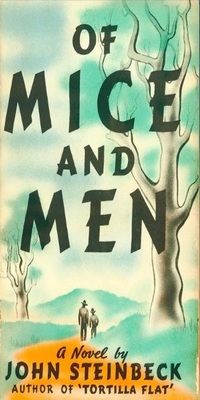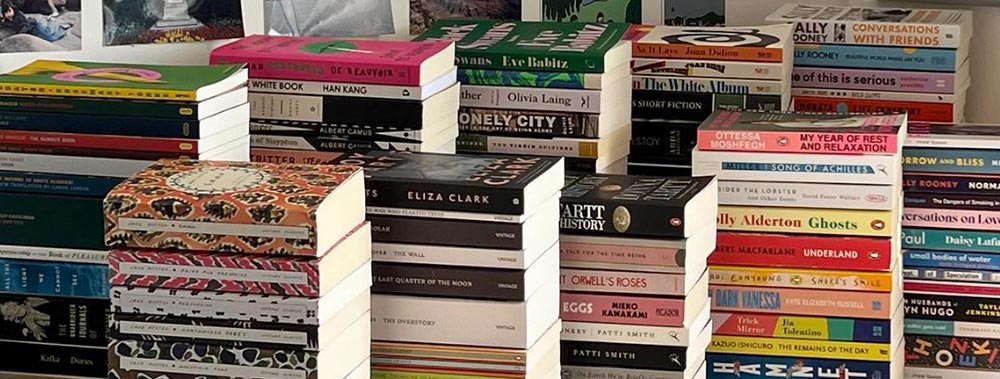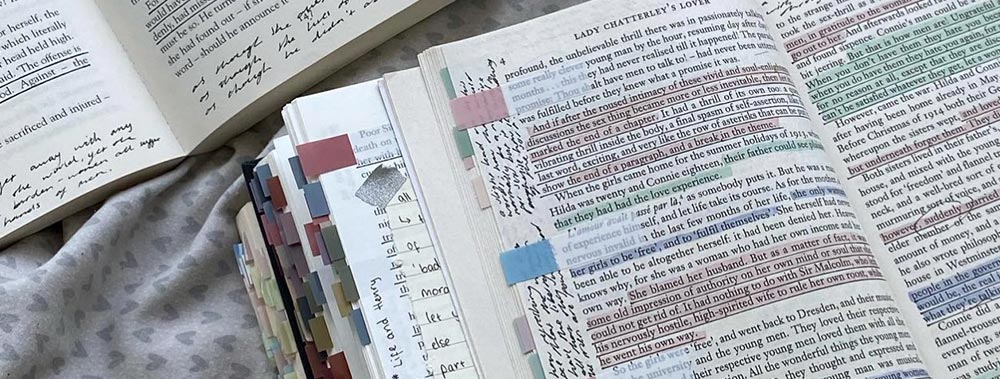Of Mice and Men: Summary, Plot, Characters, Literary Analysis & More
“Of Mice and Men” is a novel by John Steinbeck, first published in 1937.
It stands as one of Steinbeck’s most esteemed literary achievements, exploring themes of social class, human worth, and the American Dream.
The story follows George Milton and Lennie Small, migrant farm workers during the Great Depression, as they navigate a world of dreams and hardships.
The narrative encompasses moments like George’s retelling of their shared aspirations and Lennie’s accidental transgressions, leading to an unforgettable climax where George is faced with a heart-wrenching decision.
Steinbeck’s poignant portrayal of friendship, sacrifice, and the fragility of dreams captivates readers amidst the backdrop of the challenging times faced by these characters.
Of Mice and Men Summary
In the gripping narrative of “Of Mice and Men,” George and Lennie, seeking the elusive dream of owning a farm, forge an unbreakable bond during the Great Depression.
The tale unfolds with a haunting image of a dead mouse, symbolizing their fragile hopes. You can find more about this particular episode in our “Of Mice and Men” Chapter 1 summary.
As tension escalates, George faces the heart-wrenching dilemma of protecting Lennie from his own strength.
Tragedy strikes when Lennie unintentionally harms Curley’s wife, leading to George’s heartbreaking decision to shoot him to spare him from further harm.
Steinbeck masterfully explores themes of shattered dreams and the complexities of friendship, leaving readers with an indelible emotional resonance.

Steinbeck's poignant portrayal of friendship, sacrifice, and the fragility of dreams captivates readers amidst the backdrop of the challenging times faced by these characters.
Table of Contents
Summary The Plot Characters Key Themes Genres Language used Literary devices Summing upThe Plot
John Steinbeck’s “Of Mice and Men” delves into the lives of two itinerant workers, George and Lennie, as they navigate a world of hardship and companionship.
Lennie’s impulsive actions, including grabbing Curley’s fist, put them at odds with ranch workers, intensifying the struggle to protect him from his own innocence.
The story is woven with poignant encounters, including those with Curley’s wife, whose dreams remain unfulfilled.
Through Steinbeck’s artful narrative, the novella uncovers layers of the human condition against the backdrop of the Great Depression, illuminating the challenges of safeguarding dreams and finding connection amidst adversity.
Characters
A compelling array of characters comes to life against the backdrop of the Great Depression.
Steinbeck masterfully crafts a cast of characters, each with their own dreams, flaws, and struggles, showcasing the spectrum of human aspirations and vulnerabilities during a time of economic turmoil and social upheaval.
Through its vivid characters, “Of Mice and Men” explores themes of companionship, loneliness, the pursuit of the American Dream, and the inevitable clash between individual desires and societal constraints.
George Milton
George is a pragmatic and caring friend, taking on the role of protector for his mentally impaired companion, Lennie.
Through retelling dreams of a better life, George embodies the enduring hope of the downtrodden during the Great Depression.
Lennie Small
Lennie’s immense strength is matched by his childlike innocence, often leading to unintended consequences like accidentally killing small animals.
His desire for soft things and his tragic encounter with Curley’s wife form a poignant exploration of vulnerability in a harsh world.
Curley’s Wife
Curley’s wife yearns for a life beyond her confined existence on the ranch, her flirtatious nature reflecting the loneliness that pervades her.
Trapped in a loveless marriage, she becomes a symbol of unfulfilled aspirations and shattered dreams.
Curley
Curley, the ranch owner’s son, is characterized by his aggression and his obsession with asserting his dominance.
His confrontations, including an altercation with Lennie, highlight the fragility of power and masculinity in a world filled with uncertainty.
Candy
Candy, an aging ranch hand, is marked by his missing hand and his emotional connection to his old dog.
Overhearing George and Lennie’s dreams of owning land, he becomes invested in their vision as a glimmer of hope in his own life.
Slim
Slim, the skilled mule driver, stands as a figure of respect and wisdom among the ranch workers.
His understanding of nature and his support for George and Lennie reflect the camaraderie that can emerge amidst adversity.
Carlson
Carlson’s pragmatic nature is evident in his insistence on euthanizing Candy’s old dog, reflecting the harsh realities of ranch life.
His possession of a luger becomes a crucial plot point, adding an element of tension to the narrative.
Aunt Clara
Although not directly present in the story, Aunt Clara’s memory lingers through George’s recollections, serving as a reminder of Lennie’s need for guidance and protection.
Lynch Mob
Representing the dark side of human nature, the lynch mob underscores the themes of justice and cruelty.
Their pursuit of Lennie adds urgency to the story’s climax, accentuating the novel’s exploration of morality and consequence.
Key Themes
Depression.
Steinbeck exemplifies these themes through George’s ultimate decision to shoot Lennie, Curley’s wife’s unfulfilled aspirations, and the shared dreams of George and Lennie.
The novella serves as a reflection of the complexities of human relationships and the harsh realities of a world plagued by economic hardship.
Fragility of Dreams
The characters’ dreams serve as delicate threads that weave their hopes and aspirations together.
George and Lennie’s shared dream of owning a piece of land, “livin’ off the fatta the lan’,” becomes a symbol of their escape from the cycle of poverty and labor.
However, as the novella progresses, it becomes evident that these dreams are as fragile as they are inspiring. The dream of land ownership is shattered not only by external circumstances, but also by the limitations imposed by the characters’ own flaws and vulnerabilities.
Lennie’s inability to control his immense strength and his childlike mentality ultimately leads to a tragic outcome that irrevocably destroys their dream.
The dreams of other characters, such as Curley’s wife’s desire for stardom and Candy’s yearning for companionship, also meet similar fates, highlighting the fragility of aspirations in a world where external forces and personal limitations conspire to thwart even the most heartfelt dreams.
Isolation and Loneliness of Individuals
“Of Mice and Men” portrays a world where isolation and loneliness are pervasive. The itinerant nature of the ranch work means that characters are constantly moving, forming temporary connections that are often shallow and fleeting.
George and Lennie’s unique companionship stands out amidst this loneliness, emphasizing the rarity of genuine connections.
Other characters, such as Candy, Crooks, and Curley’s wife, experience different forms of isolation due to their age, race, or gender. Crooks, the African American stable hand, is marginalized both racially and socially, leading to his emotional and physical solitude.
Curley’s wife, a character whose name is never revealed, is trapped in a loveless marriage and longs for conversation and attention, but is ostracized by the men on the ranch.
Steinbeck’s portrayal of these characters’ loneliness underscores the universal human need for connection and belonging, while also shedding light on the challenges of forging such bonds in an era of economic instability.
Pursuit of the American Dream during the Great Depression:
The American Dream, traditionally seen as a promise of prosperity, success, and upward mobility, takes on a complex and often disillusioning form in “Of Mice and Men.”
The characters’ dreams reflect their desire to escape the hardships of their current lives and attain a better future. However, the harsh reality of the Great Depression undermines these aspirations.
The ranch workers’ constant struggle for survival highlights the disconnect between their dreams and the economic realities of the time.
Even when characters like George and Lennie momentarily glimpse the possibility of their dream coming true, external factors beyond their control intervene.
The dream of land ownership, for instance, is thwarted by the unrelenting grip of poverty and the lack of opportunities.
This depiction of shattered dreams speaks to the broader disillusionment felt by many during the Great Depression, as the promise of the American Dream seemed increasingly out of reach for countless individuals struggling to make ends meet.
Genres in Of Mice and Men
Novella encompasses the genres of both novella and tragedy.
The novella format allows for concise yet impactful storytelling, while the tragic elements are evident in the unfulfilled dreams and the heart-wrenching conclusion.
Steinbeck’s blending of these genres enables a poignant exploration of human aspirations and the inevitable struggles that arise, resonating deeply with readers.
Language used in Of Mice and Men
Steinbeck employs a vivid and emotive language style in “Of Mice and Men” to evoke the atmosphere of the Depression-era setting and the characters’ emotions.
His language captures both the simplicity and complexity of the characters’ lives, as seen when George retells their shared vision of a better future.
Through poignant descriptions and dialogue, Steinbeck brings to life the struggles, dreams, and aspirations of the characters, immersing readers in their world.
Literary devices in Of Mice and Men
“Of Mice and Men” by John Steinbeck employs various literary devices to enhance its narrative impact. Symbolism is evident in elements like Curley’s wife, embodying shattered dreams, and the title itself, representing the vulnerability of individuals in a callous world.
Steinbeck’s use of foreshadowing heightens tension, as George’s warning to Lennie and the presence of mice allude to the tragic climax.
The novella’s exploration of human nature and the complexities of relationships is heightened through Steinbeck’s skillful use of imagery, characterization, and themes, making it a masterful literary work.
Similes
John Steinbeck employs impactful similes to amplify reader engagement and comprehension. As Lennie grabs Curley’s fist, his grip is compared to a vice grip, vividly illustrating his raw strength and impending conflict.
When George shoots Lennie, the act is described as happening swiftly, like a bolt of mercy, encapsulating the complexity of their relationship and the heartrending necessity of the action.
These similes intensify sensory experiences, offering deeper insight into characters and their emotions, elevating pivotal moments for a more resonant and empathetic reading experience.
Metaphors
John Steinbeck employs metaphors in “Of Mice and Men” to convey profound meanings. George’s vigilant warnings to Lennie serve as metaphors for the broader theme of safeguarding delicate dreams in a harsh world.
The moment George finds Lennie echoes the role of a watchful guardian, metaphorically reflecting his overarching responsibility. These metaphors enrich the exploration of themes like companionship, sacrifice, and the struggle to nurture aspirations amidst adversity.
Through them, Steinbeck crafts a narrative that resonates deeply, inviting readers to contemplate the intricacies of the human experience.
Analogies
John Steinbeck employs insightful analogies in “Of Mice and Men” to elucidate complex concepts. George’s constant effort to protect Lennie, akin to guarding a fragile ember from gusts, underscores the novel’s theme of nurturing dreams in adversity.
He warns Lennie, akin to a seasoned navigator advising in treacherous waters, to symbolize guidance in a harsh world.
The analogy when Lennie accidentally kills his puppy, a delicate creature in his care, mirrors the tragic consequences of his strength, reflecting a broader exploration of innocence inadvertently causing harm. These analogies deepen the narrative, enabling readers to grasp intricate ideas more profoundly.
Imagery
John Steinbeck masterfully employs vivid imagery in “Of Mice and Men,” creating sensory experiences that resonate with readers. As a friend to Lennie, George’s bond is palpable through their shared dreams, akin to a tapestry woven with aspirations.
When George asks Candy about his farm plans, the imagery paints a hopeful picture of a better future amidst bleakness.
The scene where Lennie watches the unfolding events mirrors a silent observer amid chaos. The haunting image of the dead puppy and George’s narration, as he tells Slim of their dreams, evoke powerful emotions, immersing readers in the characters’ world.
Symbolism
Through careful analysis, John Steinbeck weaves profound symbolism into the novella, enriching its themes. As Curley’s wife enters, she embodies shattered dreams and unfulfilled potential, symbolizing the lost aspirations of marginalized individuals.
The scene where she reminds Lennie of his puppy’s fate illustrates how innocence can inadvertently lead to tragic outcomes, mirroring the broader theme of unintended consequences.
Lennie’s firing from his job (Curley got Lennie fired) symbolizes society’s struggle to accommodate those who don’t fit societal norms. These symbols intricately connect to larger themes, heightening the narrative’s emotional impact.
Personification
Instances of personification in John Steinbeck’s novella add depth to characters and settings. As George hesitates, the hesitation takes on a human quality, revealing inner conflict.
Similarly, when George answers, his response gains a personal touch, reflecting his emotional state. When Lennie sits, it conveys a sense of reflection and contemplation, as if Lennie possesses human-like thought processes.
Personification breathes life into the narrative, allowing readers to empathize with the characters and perceive the environment as a living entity, ultimately enhancing the story’s immersive quality.
Hyperbole
John Steinbeck strategically employs hyperbole to amplify the narrative’s impact. As George tells Slim about their dream farm, his words soar beyond reality, magnifying their aspirations.
When Lennie’s aunt’s voice echoes in George’s explanations, it metaphorically emphasizes her influence, heightening their connection. The notion of a dream farm stretches beyond possibility, emphasizing the characters’ longing for a better life.
Through hyperbole, Steinbeck accentuates emotions, dreams, and relationships, intensifying the novella’s emotional resonance, while also reflecting the exaggerations inherent in human hopes and desires.
Irony
John Steinbeck employs various types of irony, enriching the narrative’s texture and resonance. When Lennie steals Carlson’s luger, situational irony arises as the tool meant for protection leads to unforeseen tragedy.
As George finds Lennie by the Salinas River, verbal irony emerges when George’s words convey an air of nonchalance, masking his deeper emotions. George’s explanation of their dream farm, juxtaposed with the harsh reality of their lives, underscores dramatic irony, highlighting the characters’ unfulfilled dreams.
Steinbeck’s skillful use of irony enhances the story’s complexity and emotional impact, inviting readers to delve deeper into its layers.
Juxtaposition
In the book, juxtaposition is deftly employed to illuminate contrasts and evoke contemplation. The camaraderie of George as a friend to Lennie stands against the harsh reality they face.
When George tells Lennie about their dreams, the stark contrast between aspiration and adversity is evident. The scene where George explains Lennie’s aunt’s wishes showcases the tender aspirations set against a world marked by struggle.
Through these juxtapositions, Steinbeck provokes readers to reflect on the dissonance between dreams and reality, adding depth and resonance to the narrative.
Paradox
John Steinbeck artfully employs paradoxes unraveling deeper meanings. George’s role as his friend Lennie encompasses both guardian and reliant, revealing the duality of their relationship.
Following Lennie’s Aunt Clara’s death, paradoxically, her memory persists, guiding George’s actions. The mention of Lon Chaney in San Francisco carries an ironic undertone, as the city symbolizes dreams yet contrasts with Chaney’s tragic characters.
These paradoxes illuminate the intricate layers of human connection, aspirations, and reality, contributing to the novel’s poignant exploration of life’s complexities.
Allusion
John Steinbeck subtly weaves literary allusions in “Of Mice and Men,” enriching its context. As Curley’s wife walks, her characterization bears semblance to the archetype of marginalized women in literary history, echoing societal constraints.
The struggles of ranch hands parallel those faced by migrant workers during the Great Depression, invoking historical resonance. When Candy overhears discussions about the future, it reflects the anxieties of a disempowered class.
The ranch foreman embodies authority figures, echoing real-world power dynamics. These allusions deepen the narrative’s layers, connecting characters and events to broader cultural and historical threads.
Allegory
John Steinbeck’s “Of Mice and Men” subtly incorporates allegorical elements to convey broader themes. The smelly dog, representative of the old and discarded, mirrors the marginalized characters on the ranch.
Curley’s wife’s dreams serve as a microcosm of unfulfilled aspirations amidst a larger world of shattered hopes. As George understands the challenges Lennie faces, it reflects society’s duty to protect vulnerable members.
The narrative of George’s interactions with Lennie alludes to the complexities of human relationships. Allegorical hints, such as the lynch party and dreams of becoming a movie star, underscore societal tensions and desires.
Lennie’s innocence, especially Lennie, represents the purity that contrasts with the harsh realities of the world.
Ekphrasis
Steinbeck employs ekphrasis to vividly describe Curley’s wife dreams, offering a glimpse into her desires through visual imagery. When George told Lennie about their envisioned farm, he paints a mental picture of a future haven, igniting readers’ imaginations.
As George asks Lennie to conjure the shared dream, it becomes a captivating mental canvas, drawing readers into their aspirations. The request to leave George symbolically encapsulates an imagined departure, an artistic representation of a potential future.
These instances of ekphrasis add layers of sensory engagement and evoke the characters’ dreams with remarkable clarity.
Onomatopoeia
In John Steinbeck’s “Of Mice and Men,” onomatopoeic words infuse auditory dimensions into the narrative. The phrase “Lennie watched” resonates with the crispness of observation, immersing readers in his gaze.
The gentle “George takes” imparts a tactile sense to the action, while the poignant description of “Candy’s dog” introduces a heartrending melody.
The onomatopoeia enriches the text with sensory details, engaging readers’ senses and fostering a deeper connection to the characters’ experiences.
Puns
Steinbeck weaves clever puns into “Of Mice and Men,” contributing humor and double meanings. The description of Curley’s hand as “handy” plays on both his name and his belligerence, adding a touch of irony.
The mention of Slim’s dog alludes to the dog’s physical condition and its master’s personality. The phrase “find Lennie” resonates with both literal and metaphorical implications, hinting at the characters’ emotional journeys.
Through puns, Steinbeck artfully layers humor and depth, enlivening the narrative’s texture and offering readers moments of wit and reflection.
Repetition
Steinbeck employs repetition in “Of Mice and Men” to underscore themes and enhance emotional resonance. The motif of Lennie’s past as an amateur boxer serves as a reminder of his strength and the potential for unintended harm.
The recurring appearance of the giant rabbit mirrors Lennie’s anxieties and symbolizes the weight of his actions. As Curley starts confrontations, the repetition highlights his aggression and foreshadows conflict.
The descriptor of a flirtatious wife adds complexity to Curley’s wife’s character. Through repetition, Steinbeck deepens thematic exploration and intensifies the novella’s emotional impact, inviting readers to delve beneath the surface.
The Use of Dialogue
Conversations reveal character traits, as Lennie’s innocence and George’s protectiveness unfold through their interactions. Dialogue also serves as a vehicle for themes, such as the pursuit of the American Dream and isolation.
The tension between characters, like Curley and his wife, is palpable through their exchanges. Steinbeck’s adept use of dialogue weaves a narrative tapestry that not only furthers the plot but also delves into psychology, relationships, and the human condition.
Word Play
In John Steinbeck’s “Of Mice and Men,” wordplay enriches the narrative. Instances like Curley’s repeated references to his notices the cuts on Lennie’s face, underscore his aggression while revealing his insecurity.
When Candy finds the possibility of escape through George and Lennie’s dream farm, it adds layers to the conversation. The description of a young woman in a harsh environment juxtaposes innocence with the surrounding realities.
The bunk house represents both physical shelter and emotional confinement. Through wordplay, Steinbeck intricately infuses the story with layers of meaning and nuance.
Parallelism
Steinbeck employs parallelism in “Of Mice and Men” to enhance the structure and convey thematic resonance. The recurring theme of dreams is paralleled in the characters’ aspirations, such as George’s retelling and Candy’s yearnings.
The parallel descriptions of the bunk house and the young woman contrast the starkness of their environment and her delicate presence. These instances create thematic echoes, highlighting the characters’ shared struggles and dreams.
Through parallelism, Steinbeck constructs a narrative that’s cohesive, layered, and rich in meaning, inviting readers to explore deeper connections.
Rhetorical Devices
Steinbeck employs various rhetorical devices in “Of Mice and Men” to evoke a persuasive impact. Rhetorical questions, like George’s query about the potential for happiness, prompt introspection and engage readers in contemplating life’s complexities.
Parallelism, seen in George’s retelling and the shared aspirations of characters, underscores thematic depth and unity. Through these devices, Steinbeck invites readers to grapple with the characters’ dilemmas and broader societal issues, encouraging critical reflection.
The artful use of rhetoric adds layers of persuasion, enhancing the novella’s resonance and encouraging readers to delve into its profound themes. Now, let’s see of mice and men summary and some final points before we go.
Of Mice and Men: FAQs
Here, we address key aspects of the novella, explore its characters, themes, and the context that shaped its creation.
Whether you’re a first-time reader seeking clarity or a devoted fan looking to deepen your appreciation, this section is designed to illuminate the nuances of John Steinbeck’s timeless work and enrich your literary journey.
What is the main idea of “Of Mice and Men”?
The main idea revolves around the aspirations, friendships, and hardships of two displaced ranch workers, George and Lennie, as they strive to achieve their dream of owning a piece of land during the Great Depression.
Where does “Of Mice and Men” take place?
The story is primarily set on a ranch in the Salinas Valley of California during the Great Depression.
How does “Of Mice and Men” end?
The story ends tragically with the mercy killing of Lennie by George, who shoots Lennie to spare him from a potentially violent and unjust fate at the hands of others.
Why is it called “Of Mice and Men”?
The title is taken from a line in Robert Burns’ poem “To a Mouse”: “The best laid schemes o’ mice an’ men / Gang aft agley,” which means that even the most well-thought-out plans can go awry. This reflects the fragility of the characters’ dreams and their struggles against uncontrollable forces.
Why was “Of Mice and Men” banned?
The novella has faced bans and challenges in various places due to its language, sexual content, and themes of violence. Some critics have also raised concerns about its suitability for certain age groups.
What kind of story is “Of Mice and Men”?
“Of Mice and Men” is a classic work of American literature that falls under the genres of both novella and tragic fiction.
What happens when George shoots Lennie?
In a heart-wrenching moment, George mercifully shoots Lennie to spare him from an impending violent fate at the hands of others. This decision illustrates their enduring friendship and George’s desire to protect Lennie from the harsh realities of the world.
Who carries a dead mouse in his pocket and why?
Lennie carries a dead mouse due to his fascination with soft textures. However, the unawareness of his own strength leads to its unintentional demise, foreshadowing the recurring theme of Lennie’s accidental harm to innocent creatures.
Who is the target group for this book?
The book’s themes of friendship, dreams, and adversity resonate with readers of various ages. High school and college students often study it for its literary significance, but its universal exploration of the human condition makes it accessible and thought-provoking for a wide range of readers.
Summing up: Of Mice and Men: Summary, Plot & More
“Of Mice and Men” by John Steinbeck emerges as a poignant exploration of human dreams, companionship, and the adversities of the Great Depression era.
Through vivid characters like George and Lennie, Steinbeck delves into the complexities of friendship and the challenges of nurturing aspirations amidst a harsh reality.
The novella’s thematic richness is enhanced by the masterful use of literary devices, from poignant imagery to thought-provoking allegory.
Steinbeck’s narrative prowess comes to life through his astute portrayal of characters like Curley’s wife, the bunkhouse inhabitants, and Candy’s dog, each symbolizing broader societal themes and evoking empathy.
The strategic application of dialogue and rhetoric draws readers into the characters’ struggles, inviting reflection on universal questions of identity, belonging, and the elusive American Dream.
The enduring appeal of “Of Mice and Men” lies in its ability to transcend its historical context and resonate with readers across generations.
Its exploration of human desires shattered hopes, and the bond between individuals in the face of adversity creates a timeless narrative that provokes contemplation and touches the heart.
In the tapestry of its themes and characters, “Of Mice and Men” stands as a literary masterpiece that continues to captivate and move readers, a testament to Steinbeck’s enduring legacy.
Other Notable Works by John Steinbeck
If you are captivated by “Of Mice and Men,” you might find these other notable works by John Steinbeck equally compelling:
- “The Grapes of Wrath“: A powerful exploration of the Great Depression’s impact on a family’s journey to find a better life.
- “East of Eden“: A sweeping family saga that delves into themes of good and evil, drawing parallels to the Biblical tale of Cain and Abel.
- “Cannery Row“: A heartwarming yet bittersweet narrative set in a colorful community during the Great Depression.
- “The Pearl“: A parable about the consequences of wealth and greed, centered around a valuable pearl.
- “Travels with Charley“: A travelogue detailing Steinbeck’s cross-country journey with his poodle, offering insights into America’s diverse landscapes and people.
These works, like “Of Mice and Men,” showcase Steinbeck’s ability to weave intricate stories that resonate with universal themes, emotions, and human experiences.







